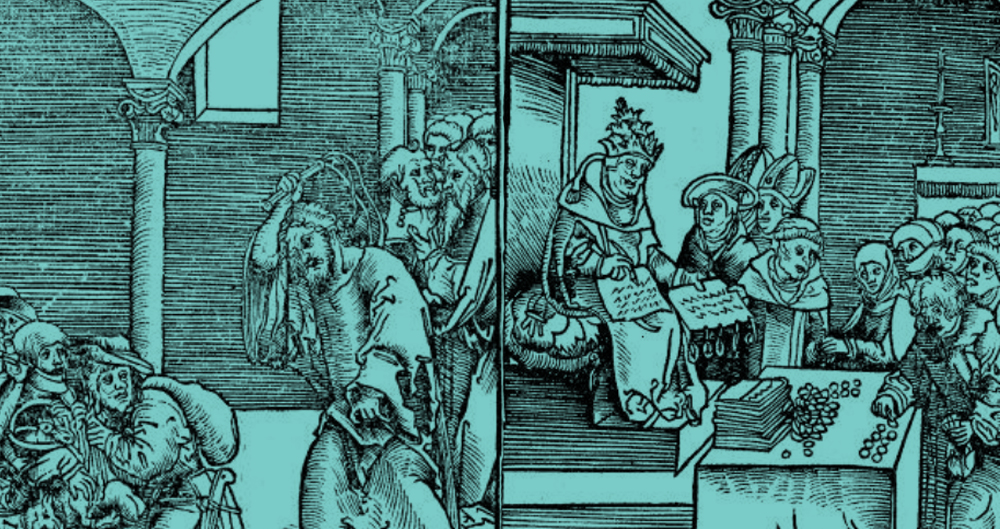As we celebrate the 500th anniversary of the Protestant Reformation, it would be wrong to place the responsibility solely on one ex-Augustinian Monk, Martin Luther. Like many of us, in our own personal achievements, we often have our friends to thank. Lucas Cranach, (the Elder) 1472-1553, was one of these friends. A witness at Luther’s wedding in 1525, godfather to Luther’s first born son, but most importantly, an instrumental companion in the Reformation. Cranach embraced the ideas of Luther and partnered with him in constructing influential pamphlets (flugschriften). With a splash of artistic flair, Cranach made Luther’s theology available and understandable to almost anybody.
Justification by Print Alone?
It is often pointed out that without the invention of the printing press the Reformation would have been impossible. Thanks to Johann Gutenberg (and other German artisans), in around 1450, printing with movable metal type was invented. Luckily for the Protestant reformers, by the turn of the sixteenth century, over two hundred cities across Europe obtained this new printing technology. We often speak of Luther’s famous “Ninety-Five Theses,” and assume that this was a unique and purposeful attempt to overthrow papal authority, however, the success took even Luther by surprise. Writing to his friend Christopher Scheurl in March 1518, Luther stated, “I did not wish to have them [the Theses] widely circulated, I only intended submitting them to a few learned men for examination.”
The reality was that people were reading them throughout Germany within a fortnight, and throughout Europe within a month (even England’s Lord Chancellor, Thomas More, received a copy). The almost accidental success of Luther’s Ninety-Five Theses flicked a switch in the minds of the Protestant reformers, and while print had existed for some time, it was Protestantism, and mainly Luther, who started to exploit it.
Faith Comes by Seeing
While the impact of print cannot be ignored, neither can the fact that while Luther’s Ninety-Five Theses were circulating Germany, only 5 per cent of the population could actually read them. What is worse, many suffered from poor eye sight, and while spectacles were available towards the end of the thirteenth-century, they were expensive to craft and were often worn only by the rich and elderly. The reality was that only two major forms of communication existed, oral and visual. The former meant crowds could listen intently to the ideas printed on decorative pamphlets. But what was more liberating and effective was being able to independently gaze at the visual images inside these pamphlets, and without needing to read them, one could understand them! This is where the significance of Lucas Cranach unfolds.
Reading Pictures: The Impact of Cranach
Lucas Cranach was a Renaissance man; a gifted artist, the court painter to the electors of Saxony, one of the wealthiest entrepreneurs in Wittenberg, and a regularly appointed Mayor of the town. Yet it was his artistic prowess, through his visual creations on woodcuts, which helped to communicate the ideas of the Reformation to almost anyone. An example of his work is the popular Passional Christi und Antichrist.
This pamphlet, produced in 1520, consisted of 26 Cranach woodcuts and was a widely circulated booklet. But it is Cranach’s images which are significant here. Given the low literary rates of the early sixteenth-century, these images helped to communicate to all, one of the central aspects of Luther’s theology, namely, the corrupt state of the established church. It is clear from this pamphlet that there were 13 different comparisons being made between the Gospel accounts of Jesus, and the current Pope, Leo X.
 This particular illustration shows the account from John 13, where Jesus washes and kisses the feet of one of his disciples, an example of the humility and service of Christ. In direct comparison, the Pope is depicted, sat on a throne, proudly delighting over the line of people waiting to kiss his feet. Another example below shows the life of Christ contrasted with the life of the Papal “Antichrist.” Jesus on the left is shown driving out the money-changers from the temple, drawn from Matthew 21. On the right however, the Pope is shown counting the sale of indulgences—a clear contrast. As we can see, regardless of whether you could read, the message was clear: if we can’t trust the established church, who can we trust?
This particular illustration shows the account from John 13, where Jesus washes and kisses the feet of one of his disciples, an example of the humility and service of Christ. In direct comparison, the Pope is depicted, sat on a throne, proudly delighting over the line of people waiting to kiss his feet. Another example below shows the life of Christ contrasted with the life of the Papal “Antichrist.” Jesus on the left is shown driving out the money-changers from the temple, drawn from Matthew 21. On the right however, the Pope is shown counting the sale of indulgences—a clear contrast. As we can see, regardless of whether you could read, the message was clear: if we can’t trust the established church, who can we trust?
Cranach created multiple significant images during the Reformation, from typical portraits of Luther in his earlier years, all the way to supplying key images to accompany Luther’s German translation of the New Testament. However, there was none as popular as Passional Christi und Antichrist. Yet with each image, Cranach powerfully communicated the ideas of the Reformation to those who could not read about them. While we often are quick to admire the impact of the written words of the Reformation, it is worth remembering that for the vast majority of people, it was Cranach’s visual creations which helped to communicate and spread the ideas of the Reformation.




